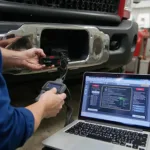Erasing global OBD2 Diagnostic Trouble Codes (DTCs) is a common procedure for car owners and mechanics. It allows you to clear the check engine light and start fresh with your vehicle’s diagnostics. But before you erase global obd2 dtc, it’s crucial to understand the process and potential implications. This comprehensive guide will walk you through everything you need to know.
Understanding OBD2 Diagnostic Trouble Codes
OBD2 DTCs are codes stored in your vehicle’s computer that indicate a potential problem. They are triggered when a sensor detects an issue within a specific system. These codes are essential for diagnosing car problems and ensuring your vehicle runs smoothly. obd2 civics provide valuable insights into how these codes function.
Why Would You Erase Global OBD2 DTCs?
There are several reasons why you might want to erase global OBD2 DTCs:
- After a Repair: After fixing the underlying issue that triggered the code, erasing the DTC confirms the repair was successful.
- Intermittent Issues: If you’re experiencing an intermittent problem, clearing the codes can help you isolate the issue when it reappears.
- False Positives: Occasionally, DTCs can be triggered by minor glitches or sensor malfunctions. Erasing them can rule out these false positives.
How to Erase Global OBD2 DTCs
The most common way to erase global OBD2 DTCs is using an OBD2 scanner.
- Locate the OBD2 Port: The OBD2 port is usually located under the dashboard on the driver’s side.
- Connect the OBD2 Scanner: Plug the scanner into the OBD2 port.
- Turn on the Ignition: Turn the ignition key to the “on” position, but don’t start the engine.
- Access the DTCs: Navigate through the scanner’s menu to access the stored DTCs.
- Erase the Codes: Select the option to erase or clear the DTCs. The scanner will confirm the process.
Important Considerations Before Erasing Codes
While erasing global obd2 dtc is a relatively simple process, there are some crucial factors to consider:
- Identifying the Root Cause: Simply erasing the code doesn’t fix the underlying problem. It’s essential to diagnose and repair the issue before clearing the codes.
- State Inspections: In some states, erasing codes before an emissions test can lead to failure.
- Data Loss: Erasing codes can also erase valuable diagnostic data that could help a mechanic pinpoint the problem.
What Happens After Erasing Codes?
After you erase global obd2 dtc, the check engine light will turn off. However, if the underlying issue persists, the light will come back on. The vehicle’s computer will also start monitoring the relevant systems again to detect any further problems. You can find helpful information about specific scan tools like cen tech obd2 & can scan tool on our website.
Conclusion
Erasing global OBD2 DTCs is a useful tool for both car owners and mechanics. However, it’s crucial to understand the process and its implications. Always address the underlying issue causing the code before clearing it to ensure your vehicle runs smoothly and safely. Remember to diagnose the problem first before erasing global obd2 dtc.
FAQ
- Will erasing codes damage my car? No, erasing codes will not damage your car.
- Can I erase codes without a scanner? Some vehicles have specific procedures for erasing codes without a scanner, but using a scanner is the most common and reliable method.
- How long do codes stay erased? Codes will remain erased unless the underlying problem triggers them again.
- Will erasing codes reset my car’s computer? Erasing codes typically only clears the stored DTCs and doesn’t perform a full reset of the car’s computer.
- Why is my check engine light still on after erasing codes? If the check engine light remains on after erasing codes, it indicates the underlying problem persists and needs further diagnosis.
- Can I drive with codes erased? Yes, you can drive with the codes erased, but it’s crucial to address the underlying issue if one exists.
- How often should I erase codes? You should only erase codes after a repair or to troubleshoot an intermittent issue.
Common Scenarios:
- Scenario 1: You’ve replaced a faulty oxygen sensor. Erase the codes to confirm the repair.
- Scenario 2: Your check engine light came on intermittently. Erase the codes to monitor for the issue to reappear.
- Scenario 3: You’ve diagnosed a problem and want to ensure the repair was successful. Erase the codes after the repair.
Related Articles:
- Check out our article on OBD2 codes for specific car makes and models.
- Learn more about using OBD2 scanners for advanced diagnostics.
For assistance, contact us via WhatsApp: +1(641)206-8880, Email: [email protected] or visit our office at 789 Elm Street, San Francisco, CA 94102, USA. Our customer support team is available 24/7.


